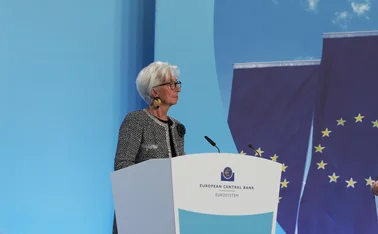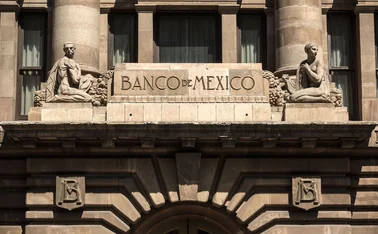
ETFs: a gateway to sustainability?

Antarctic sea ice reached its lowest June coverage on record this year. Key trade waterway levels fell amid soaring temperatures this summer. Millions have lost their homes in flooded Pakistan. Electrical grids are struggling in countries such as Iraq – where temperatures have reached 50° Celsius – and the US. Wildfires and extreme heat are expected to exacerbate the global food crisis.
The “tragedy of the horizon”, as Mark Carney described inaction on climate change in 2015, includes central banks. Bound by their mandates, the horizons for monetary (two to three years) and financial stability policies – on the upper bounds of credit cycles lasting around a decade – introduce the risk that, by the time climate change becomes a defining issue, “it may already be too late”. The “far-sighted” among us are anticipating “global impacts on property, migration and political stability, as well as food and water security”, Carney warned.
While some central bankers are still debating whether they have a role to play in sustainable investing through greening their own reserves, others are engaging in the practical difficulties of how to achieve this.
Central Banking spoke to officials at the Hong Kong Monetary Authority (HKMA) and the Central Bank of Morocco about their experiences and views on ESG, and sustainable investing. Officials from the National Bank of Denmark spoke in detail about using Paris Agreement on climate change-aligned exchange-traded funds (ETFs) under their new sustainability guidelines. Leading ESG rating company MSCI also spoke about what its ESG scores do and don’t measure, and their ETF Paris-Aligned Benchmarks (PABs).
A new phase
The Network for Greening the Financial System (NGFS) brings together central banks and supervisors to develop environment and climate risk management in the financial sector. It was founded in 2017 by central banks in Mexico, the UK, France, the Netherlands, Germany, Singapore and China. Today, 114 central banks have joined the NGFS, but their own collective exposures to sustainable investments remain low. As part of its benchmarks survey, Central Banking found green and social bonds constituted just 1% of reserves.
“Central banks are major players in the financial markets and therefore have an important role in directing capital flows towards green projects,” Younes Issami, head of the monetary and foreign exchange operations department at the Central Bank of Morocco tells Central Banking. In Issami’s view, central banks have a responsibility to facilitate “the transition to a positive-impact economy, by incorporating sustainability considerations into their portfolio management”.
The adoption of sustainable and responsible investment policies by central banks could encourage other financial operators and investors to follow suit, and thus help reduce ESG risks, he says.
A 2021 policy report, Net-zero central banking: a new phase in greening the financial system, argues that central banks and supervisors need to “introduce explicit strategies to support the transition to net-zero”. This is the next stage in confronting the risks of climate change, Nick Robins and Simon Dikau of the London School of Economics (LSE) and Ulrich Volz of the School of Oriental and African Studies, University of London, wrote. They recommend portfolio managers include a net-zero target and that central banks publish transition plans to achieve this.
Furthermore, central banks face “reputational risks stemming from inaction” on responsible investing, according to Anna Hyrske and Danae Kyriakopoulou. Hyrske, principal responsible investment specialist at the Bank of Finland and Kyriakopoulou, senior policy fellow at LSE, made their comments as part of a recent series of papers from leading policy-makers on sustainable central banking.
However, Hyrske and Kyriakopoulou also note a relatively limited range of cases where central banks can learn from their direct peers in terms of integrating sustainable and responsible investments into their portfolios. They reported that just four central banks are signatories to the international UN-supported Principles for responsible investment.
ETFs and ESG are two trends in finance that have grown significantly in recent years. ETFs may offer a way for central banks to green their reserves, but ESG scores are not synonymous with sustainability.
Understanding ESG ratings
No definitive taxonomy of Environmental, Social and Governance factors exists. “The use of ESG scoring or, broadly, ESG data in assessing ESG risks and opportunities is a common challenge for investors and asset owners, including the HKMA,” a spokesperson tells Central Banking.
Key challenges include ESG scores covering broader E, S and G aspects than climate change and the lack of standardised and consistent methodology for measuring them. “The correlation and comparability between the scores remain low due to differing scoring methodologies and assumptions used by data providers,” the HKMA spokesperson says. The reliability of underlying data for ESG score assessments could be affected by the extent of corporate public disclosures, they add.
ESG-related assets – which stand at about $35 trillion – are expected to climb to $50 trillion in 2025, according to Bloomberg Intelligence. Last year, cumulative assets in ESG ETFs rose to $360 billion as interest in ESG accelerated. With the pressing urgency of climate change, the interest in the green part of ESG investing has propelled momentum.
Bloomberg Intelligence estimates that 60% of all the money that retail investors have ploughed into sustainable or ESG funds globally has gone into those built on MSCI’s ratings. However, “MSCI’s ESG ratings are designed for one purpose: to measure a company’s resilience to financially material ESG risks, relative to its sector,” an MSCI spokesperson tells Central Banking. MSCI’s ESG ratings measure risk to financial performance. “They are not a general measure of corporate ‘goodness’, a barometer on any single issue or a synonym for sustainable investing.”
In short, ESG does not measure a company’s risk to the world. Speaking at the 2021 UN Climate Change Conference (COP26) in Glasgow, Henry Fernandez, chairman and chief executive of MSCI, said “many portfolio managers don’t grasp that”.
Denmark’s approach
Søren Schrøder, head of risk control, at the National Bank of Denmark and a spokesperson talked about their experiences using ETFs to fulfil their sustainability requirements. Last year, the Danish central bank broadened its guidelines for responsible investments to include that its portfolios should align with the 2015 Paris Agreement to the extent possible within the primary mandate. At that stage the central bank had ESG-screened ETFs, “so it was natural for us to continue down that path for the transition towards ETFs that follow Paris-aligned indexes,” the spokesperson says.
The European Union has set minimum standards for benchmarks to comply with to be labelled as EU PABs. The purpose of this is to increase transparency and the degree of comparison, and to combat greenwashing. A range of benchmark providers have created indexes that implement the EU taxonomy. “As a first step, we took a closer look at some of these indexes to get a better understanding of the effects of the underlying ESG criteria,” the spokesperson says.
It analysed how benchmarks compared with the parent index and differences in methodologies among the various underlying index providers. “We looked at sector allocation, parent versus the PABs, as well as companies that were being excluded,” the spokesperson explains. The central bank also looked at which companies were over and underweighted. “Based on this information, we narrowed it down to a few index providers that we preferred.”
The central bank uses EU PABs for reference. The central bank’s position is that the benchmark’s minimum requirements are a good basis for passive investors to achieve well-diversified equity exposure, while avoiding the largest carbon dioxide equivalent – or CO2e – emitters.
As a next step on its way to aligning its equity and corporate bond exposure with the Paris Agreement, the Danish central bank looked at the main climate-related ETF alternatives on the market. It turned out that some PAB ETF providers had chosen to tailor-make their own Paris Agreement-aligned indexes, following dialogue with their investors, to include extra screening criteria beyond what the EU minimum criteria prescribe. As a result, the central bank had to perform the same analysis again for these Paris-aligned underlying indexes.
“Very important for us is the policy for responsible investment of the ETF provider,” the spokesperson says. As passive investors, the legal ownership and voting rights (for equities) rests with the ETF manager. As well as complying with the central banks’ guidelines for responsible investments, the central bank also requires that the ETF provider complies with some minimum standards – for example, the Principles for responsible investment.
Schrøder and the spokesperson stress that their way is not necessarily the only way to comply with being Paris-aligned. Active ownership is an alternative to exclusion – this means investors actively trying to influence companies by making demands for a green transition.
They have chosen the ETF solution that tracks PABs. But the central bank does take an active approach to understanding ETFs, as everything depends on the underlying asset. For them, ETFs were a cost-efficient way of gaining exposure and getting the PAB implemented for their equity and corporate bond exposure.
The central bank has also made an effort, particularly in the last year, to ask questions of ETF providers.
While it has been cost-efficient for the central bank, “others may not view it in the same way”, the spokesperson says. Schrøder and the spokesperson add that, while this may not be the solution for the central bank a few years ahead, it seemed “the obvious choice” at this stage.
Asked whether the central bank considered active management, the spokesperson says it has, but it requires “a lot of effort and manpower”. ETFs are therefore currently a better solution for the central bank. Schrøder and the spokesperson also stress that ETFs only account for around 3% of total reserves. “We’re doing what we can, and our starting point for getting Paris-aligned has been where the National Bank of Denmark has the greatest exposure to climate and ESG risks, investments in equities and corporate bonds,” the spokesperson says. “But we are well aware that the discussion is also relevant for sovereigns, supras and the rest of the central bank’s portfolio.”
The central bank has a responsibility to be able to intervene in FX markets at short notice to support the fixed exchange rate policy and financial stability. “Overall, we aim at investing the foreign currency reserves as responsibly as possible, with due consideration to our mandate,” the spokesperson says.
Paris-aligned innovations
Investors seeking “more nuanced assessments” or looking to understand specifically the carbon footprint and climate risks of an investment, can use climate tools that measure emissions more directly, such as Implied Temperature Rise (ITR), the MSCI spokesperson says. In MSCI’s case, “these metrics are different from ESG ratings and directly provide a climate risk assessment.”
MSCI’s ITR metric has been developed around the concept of a carbon budget. This means how much the world can emit and, by extension, how much a company can emit and remain within the limitations required to meet a 1.5°C or 2°C warming scenario by 2100.
The difficulty for investors, however, is that the global economy is not currently on track to meet the Paris Agreement’s targets. “Based on projected emissions calculations, as of May 31, 2022, only 11% of listed companies are aligned with a 1.5°C scenario,” the MSCI spokesperson says.
As a result, MSCI’s Paris-aligned indexes do not show an ITR below 2°C today. They are designed to be aligned with a 1.5°C target “over the long term”.
Sustainability data
Another issue confronting investors is the availability of company sustainability data. The greenwashing problem is mainly related to “lack of regulation” and to the “taxonomy of green investments, products and services”, when there is also growing investor demand for sustainable options, Issami of the Central Bank of Morocco, says.
The HKMA spokesperson points to ongoing international efforts to standardise and improve climate-related disclosures. For instance, work by the International Platform on Sustainable Finance to align taxonomies, and the establishment of the International Sustainability Standards Board for development of global disclosure standards “are expected to provide more consistent definitions and disclosure requirements”.
There is also some evidence more central banks may join the fight against climate change. Liquidity, safety and returns are the traditional triad of objectives by which reserve managers orient their investments. Ingo Fender, Mike McMorrow and Omar Zulaica of the Bank for International Settlements found that “68% of central bank reserve managers agree that sustainability could be included as a fourth”.
This feature forms part of the Central Banking focus report, ETFs in reserve management 2022
Only users who have a paid subscription or are part of a corporate subscription are able to print or copy content.
To access these options, along with all other subscription benefits, please contact info@centralbanking.com or view our subscription options here: subscriptions.centralbanking.com/subscribe
You are currently unable to print this content. Please contact info@centralbanking.com to find out more.
You are currently unable to copy this content. Please contact info@centralbanking.com to find out more.
Copyright Infopro Digital Limited. All rights reserved.
As outlined in our terms and conditions, https://www.infopro-digital.com/terms-and-conditions/subscriptions/ (point 2.4), printing is limited to a single copy.
If you would like to purchase additional rights please email info@centralbanking.com test test test
Copyright Infopro Digital Limited. All rights reserved.
You may share this content using our article tools. As outlined in our terms and conditions, https://www.infopro-digital.com/terms-and-conditions/subscriptions/ (clause 2.4), an Authorised User may only make one copy of the materials for their own personal use. You must also comply with the restrictions in clause 2.5.
If you would like to purchase additional rights please email info@centralbanking.com test test test








